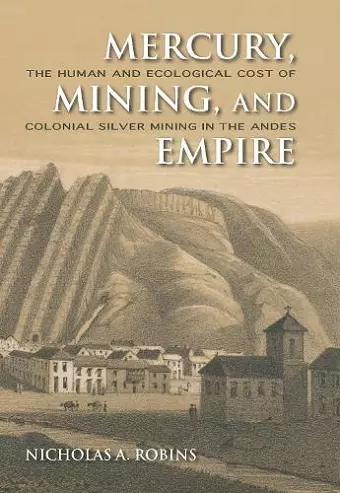Mercury, Mining, and Empire
The Human and Ecological Cost of Colonial Silver Mining in the Andes
Format:Hardback
Publisher:Indiana University Press
Published:25th Jul '11
Currently unavailable, and unfortunately no date known when it will be back

Mercury pollution's effects on the indigenous peoples of Peru and Bolivia
Discusses the effects of mercury pollution on the indigenous peoples of Peru and Bolivia
On the basis of an examination of the colonial mercury and silver production processes and related labor systems, Mercury, Mining, and Empire explores the effects of mercury pollution in colonial Huancavelica, Peru, and Potosí, in present-day Bolivia. The book presents a multifaceted and interwoven tale of what colonial exploitation of indigenous peoples and resources left in its wake. It is a socio-ecological history that explores the toxic interrelationships between mercury and silver production, urban environments, and the people who lived and worked in them. Nicholas A. Robins tells the story of how native peoples in the region were conscripted into the noxious ranks of foot soldiers of proto-globalism, and how their fate, and that of their communities, was—and still is—chained to it.
Overall, this is a fantastic book that brings together environmental, labor, and colonial history, confirming the contributions of environmental studies to understanding the past. . . . Highly recommended.
* Choice *The book itself is a distinguished contribution to the polemic on mining, colonialism, and socio-environmental degradation. It will make for a strong addition to undergraduate and graduate lists. Robins's synthetic skills, the descriptive richness of the historical source work, the verve of the writing, and the passion of the argument, all combine to make Mercury, Mining, and Empire a book [with which] to be reckoned.... August 2012
-- Daviken Studnicki-Gizbert * H-Environment *Robins combines archival work and reading of published primary materials, air pollution modeling, and knowledge of medical research on health effects of mercury exposure in a superb treatment of Andean colonial mining.
* HAHR *Overall, the book should appeal to a broad audience and could be read by undergraduates. . . . The book is rich in evidence and anecdotes about the wretched conditions that so many indigenous peoples faced throughout the colonial period.
* Environmental History *With meticulous research and vivid prose, Nicholas A. Robins examines silver mining's human cost in the royal mercury mines of Huancavelica, Peru, and the silver mines of Potosi.
* American Historical Review *In Mercury, Mining and Empire, Nicholas Robins provides a superbly researched piece of interdisciplinary history that argues that the post-Conquest genocide of the indigenous population of what is now Bolivia and Peru occurred as a result of a highly exploitative system of silver and mercury mining. Thus Robins analyzes a 'double genocide' that initially entailed the death of up to ninety percent of the indigenous peoples due to illnesses brought to the Americas by the Spanish, and continued with the subsequent genocidal destruction wrought by the toxic effects of the emerging mining industry.
* Journal of Genocide Research *Beyond being a well-written, coherent, thorough and compelling story, Robin's work offers us an indispensable cautionary tale.
* Environmental Philosophy *Robins draws on a wealth of primary sources and relevant secondary literature. In vigorous prose, he details the technology used in mines and refining mills and the horrific conditions that workers faced.
* Business History Review *This book contributes in important and novel ways to the understanding of the dramatic environmental and social consequences of silver mining as carried out from mid-16th century to late 18th century in the then Spanish viceroyalty of Peru.
* Academia.edu *Robins underscores mining's devastating heritage throughout this well-substantiated work, which will appeal to historians of mining, the economy, and those interested in the effects of global capitalism on the environment.
* Colonial Latin American Historical Review *One of the many strengths of this impressive book is Robins's use of wholly independent data sets (historical/archival and environmental studies). These intersect and make for a convincing case study. The sixty pages of endnotes, apart from a glossary and extensive bibliography, speak to Robins's thorough scholarship. This socio-environmental history, as Robins calls it, is a pathbreaking contribution to the field.
* Technology and Culture *Robin's book updates the literature on Latin American mining with ecological considerations. The academic community as well as persons interested in the ramifications and consequences of mineral extraction throughout the world would do well to read and reflect on the lessons such an analysis advances.
* Enterprise & SocieISBN: 9780253356512
Dimensions: unknown
Weight: 658g
320 pages